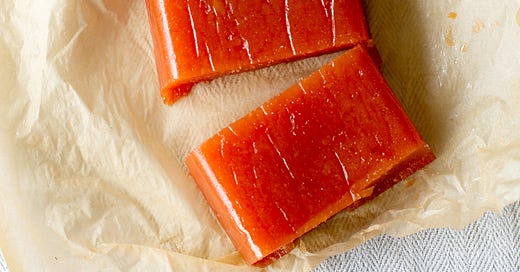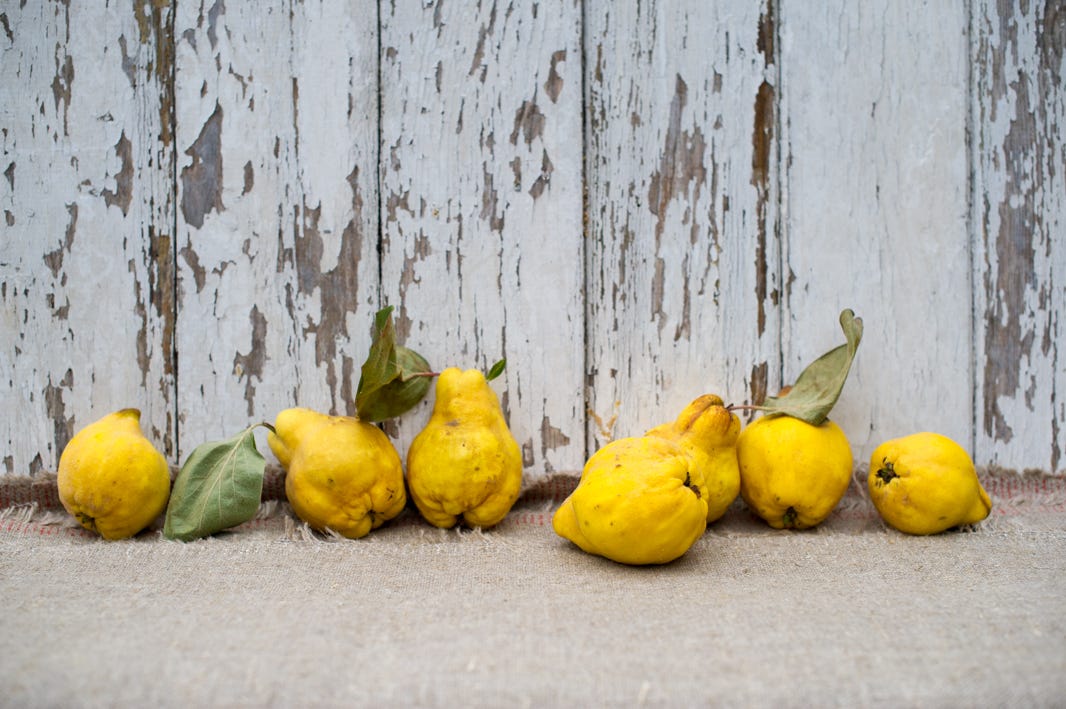As with medlars, quince are as autumnal as Nick Drake and the scent of burning applewood. Until a few years ago you either had to grow them yourself or know someone who did, but you can find them at more farmers’ markets and in more supermarkets with every year that passes.
Whatever else I might do with them - and great as they are poached, baked, vodkaed or turned into jelly - I usually make quince cheese: it keeps forever, is so good with cheese and cured meats, and you can ease it down into a jelly-like consistency with a little boiling water should you want.
In Spain this sweet, firm delight is known as membrillo. Allow a small piece, rolled in sugar, to dissolve on your tongue: don’t tell the Spanish, but it does a very passable impression of a posh fruit pastille.
Back in the day, I used to quarter and core quinces before simmering - never straight forward as they are hard an ostrich’s kneecap - but in recent years, I’ve adopted the great Pam Corbin’s method of simmering quince whole: it makes life very much easier. Don’t peel the quince - it’s a pain as they are so hard, and the skin adds pectin to the pulp, helping to set it into the cheese.
You can use any number of quince as the ingredients are few and the weight of sugar equal to that of the puree.
8 quinces
water
500g caster sugar, give or take
one lemon, cut into 8 wedges
a few drops of sunflower oil
caster sugar for dusting
In a large pan, submerge the quince in water, along with a lemon. Bring to a gentle simmer and cook until nicely soft - this can be anywhere between 45 and 90 minutes depending on the size and ripeness of the fruit. Top up with boiling water to keep the fruit covered as needed. Allow to cool, after which you can slip the flesh off the core with ease. Discard the core.
Stir in an equal volume of sugar as there is puree and simmer on a medium heat. Stir constantly. Don’t let the heat get too high unless you are wearing chainmail - the puree with thicken as it cooks and may spit as it bubbles.
Keep cooking and stirring until you can draw a spoon across the bottom of the pan and the puree takes a moment to close over behind it.
Use a flavourless oil, such as sunflower, to oil a dish or tin. Pour in the puree to a depth of 1-2cm. Leave to cool, then cover and allow to set overnight. Ease the cheese out of the dish onto a chopping board and cut into squares. Toss in caster sugar - this looks lovely and prevents the squares sticking together. Store in an airtight container in the fridge.







I get really obsessive about quince, the most fragrant and bizarre fruit. We have a couple of saplings (bought from Otter Farm, obviously) that aren’t mature enough yet to give us fruit yet so I rely on donations.
As I usually don’t get as many as I’d like, I eke them out quite meanly. I peel & core - not at all fastidiously - and get an annual ‘quince callous’ as a result. In a lean year, I use the ‘scraps’ for jelly, and the flesh for membrillo. As I have loads this year, I’ll also make a couple of batches of liqueur, a few jars of lightly stewed fruit for whatever comes up - it makes incredible stuffing for rolled pork shoulder - and some syrups. This year I’m tempted to try quince cider vinegar too.
I use honey instead of sugar in my preserves because I love the flavour and silky set. You lose some of the gorgeous colours with lighter fruit, but gain a lot from a softer sweetness that really compliments the flavour of the fruit / herbs / spices / flowers involved. I use local raw honey if it’s not being heated (liqueurs, ferments, etc), but shop-bought stuff for cooking.
This is a wonderful food to keep. It enhances any cheeseboard. Or you can add a couple of cubes of it to a Moroccan tagine. Wine pairing: Gewürztraminer.